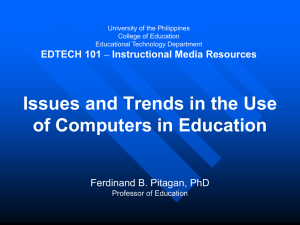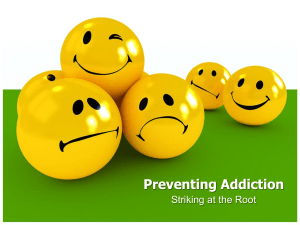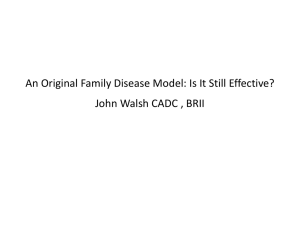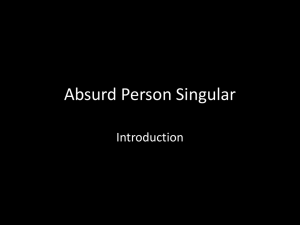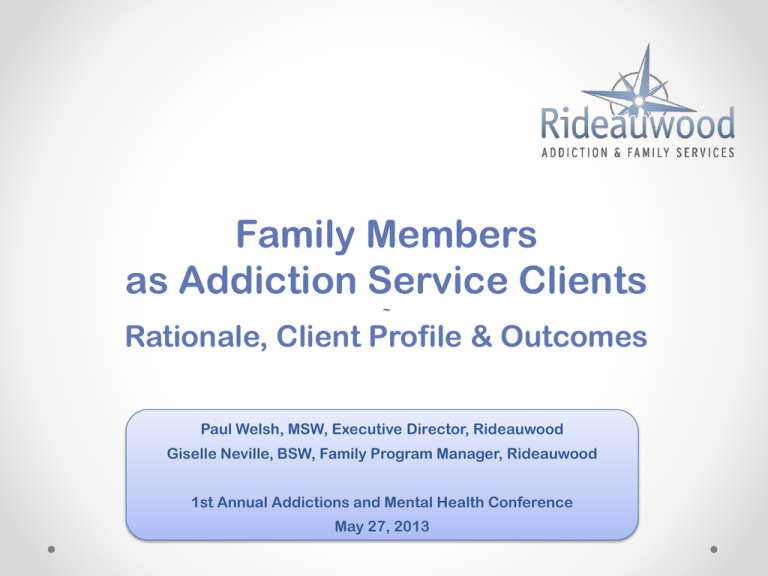
Family Members
as Addiction Service Clients
~
Rationale, Client Profile & Outcomes
Paul Welsh, MSW, Executive Director, Rideauwood
Giselle Neville, BSW, Family Program Manager, Rideauwood
1st Annual Addictions and Mental Health Conference
May 27, 2013
Overview
• Rationale for providing services to
family members.
• Client profile.
• Rideauwood’s Family Program is part
of a Whole Family Model:
• A three phase program;
• Examples of some of the tools used;
• Outcomes.
2
Client Profiles: N=124
• 87% female and 13% male
• At Intake:
40% married
19% single
15% divorced
13% separated
7% common-law relationship
6% widowed
• 15% had past history of substance
abuse themselves
3
Client Profiles Continued
• 14% had attempted suicide
• 43% had previous/current suicidal thinking
• 37% had been fearful of the addicted
person
• Client reports on emotional health:
42%” fair”
30% “poor”
21% “good”
31% reported feeling depressed
17% reported being anxious
4
Rationale
• Family members suffer from addiction in the family.
• They are the majority who suffer from addiction.
• Addiction treatment services have mandates to “reduce
suffering from addiction”.
• Addiction problems in families have unique and specific
characteristics.
• Addressing addiction problems in families requires
addiction specific knowledge and methods.
• Addiction troubles move from generation to generation.
• Breaking the cycle is a mandate of addiction services.
5
Observations, Assumptions
• Children from families with addiction have higher
prevalence of addiction, mental health, education and
relationship challenges.
• “Recovery” of any caregiver reduces those lifelong
challenges to children.
• Partners, spouses, children, parents and other family are
Primary Clients (served to address their own distress
and not “fix” the addicted person).
• Addicted persons have higher recovery rates when the
family environment is healthy.
6
Rationale – Why Provide Services to
Family Members?
Addiction wreaks
havoc on families
Psycho-education, therapy and support help family
members cope and influence addicts’ recovery
Rideauwood’s Family Program has been proven to
foster healthier individuals and families as part of a
Whole Family Model
7
Rideauwood’s Family Program Model
The Family Program
Whole
Family
Model
Coordination &
Collaboration
Supports for
Children’s Aid &
Social Services Children & Youth
Family
Intervention
Gambling
Programs
Family & Couples
Counselling
Coordination &
Collaboration
Family Community
Outreach & Education
Drug
Self-help
Residential & Non-residential
Treatment
Groups
Adult Addiction Programs
Court
Examples of Other Rideauwood and Community Services and Programs
8
The Family Program
Ontario
Works ASI
Youth
Addiction
Parent
Program
Family
Program
SchoolBased
Addiction
Youth
Justice
Addiction
Drug
Treatment
Court
Young
Adult
Concurrent
9
Client Profile
Partners and former
partners
Parents
Adult children from
families with addiction
Adult siblings
Extended family members
People in recovery
Have been, or are being
affected by addiction
Have significant stress
and coping issues
Are sufficiently stable
10
Family Member Programs
Structure
•
•
•
•
Family Spiral (2 Structured Evenings – 25 Clients);
Phase 1 (6-8 weekly groups, assessment);
Phase 2 (5 day program – 9:00-4:00 Monday to Friday);
Phase 3 (8 month weekly groups and Individual
Counselling);
• Family of Origin Program (advanced group program – 10
months).
11
On Concurrent Disorders
• Trauma informed practice is paramount.
• Eating disorders, mood disorders, personality disorders,
suicide risks, meds and drug misuse issues are
common;
• Frequent childhood abuse ranging from physical and
sexual to emotional;
• Frequent adult experiences and current abuse or;
• Client safety must be spelled out first, agreed to by all:
Expectation of emotional safety by being silent;
Expectation to be heard and validated when we speak;
Expectation to speak to counsellor individually as opposed to in a group;
Safe from criticism from emotions;
Safe to be scared and vulnerable;
Safe from gender politics, sexual advances, sexism and racism;
Safe from financial dealings or requests from clients.
12
Rideauwood’s Family Program Model
Intake
“Family
Spiral”
Initial
Support
Group
Assessment
Phase I
Five-day Intensive
Program
Phase II
Eight-month
Structured
Program
Phase III
+
Individual
Counselling
Family of Origin
Program &
Ongoing
Personal Growth
13
Phase I: Participation in the Initial
Support Group
• Provides clients a safe space to allow them
to explore their issues and feelings.
• Prepares for participation in the Family
Program.
• Continuation of psycho-education,
introduction to basic concepts, stress
release techniques.
14
Phase I: The assessment − determining
client needs
• Personal background.
• Specific issues and problems.
• If the client is a good match, they proceed to
the Five-day Intensive Program.
• If the program isn’t right for them, then
prerequisite work, or alternatives are sought.
15
Phase II − 5-day Intensive Program
• Whole Family Program Team is involved.
• Intensive day-long psycho-education, group work
and group therapy.
• Experiential exercises.
• Emotional outpouring.
16
Phase III - 8-Month Structured Program
• 32 two-hour group sessions.
• Ongoing psycho-education, group work and
group therapy.
• Experiential exercises.
• Individual counseling as required.
17
Areas of focus include
• Feelings
• Emotional
Enmeshment
“Co-dependence”?
• Detachment
• Boundaries
• Communication
• Relationships
• Grief and loss
• Self-care
18
Fostering Awareness
Using a rating scale, ranging from seldom to usually, clients
respond to a series of statements regarding their emotional
entanglement, for example:
1. I struggle to identify and express my feelings
2. I put others’ needs before mine
3. I am afraid of how others might respond if I shared
honestly with them
4. I am very loyal even if others are not loyal to me
5. I find it difficult to ask for help from others
6. . . .
19
Letting my feelings have a voice
•
•
•
•
•
•
•
•
My guilt would say . . .
My anger would say . . .
My shame would say . . .
My fear would say . . .
My sadness would say . .
My loneliness would say
My joy would say . . .
..
20
What happens if
we don’t deal with
our feelings?
21
Unchecked Negative Emotions are
Destructive:
Eating disorders
Decreased sex drive
Eyelid spasms
Stomach troubles
Tinnitus
Heart palpitations and
chest pains
Skin problems
Hair loss
Memory loss
Sleep problems
Severe headaches
Depression
Addictions . . .
22
23
24
Outcomes
25
Outcomes
•
•
•
•
•
•
•
Greater awareness about feelings.
Better communications.
Development of persistent support networks.
Improved self-esteem.
Improved health.
Better parenting.
More constructive relationships with the addict
– whether recovering or not.
• Often leads to fundamental life change.
26
27



